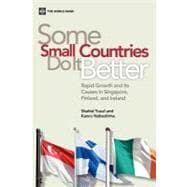
Note: Supplemental materials are not guaranteed with Rental or Used book purchases.
Purchase Benefits
What is included with this book?
| Preface and Acknowledgments | p. ix |
| About the Authors | p. xi |
| Abbreviations | p. xiii |
| Looking for Growth | p. 1 |
| Growth: The Stylized Facts | p. 7 |
| Hunting for Quarks | p. 14 |
| Looking at the "Sifire" Family of Models | p. 21 |
| References | p. 24 |
| How Sifire Compressed Development | p. 31 |
| Globalization: The Vital Backdrop | p. 32 |
| Old Light | p. 37 |
| Crises and Consequences | p. 39 |
| Investing in Growth | p. 41 |
| Learning and Innovation | p. 43 |
| Creative Cities | p. 47 |
| What Sifire Got Right | p. 48 |
| References | p. 49 |
| Elements of a Learning Economy | p. 55 |
| Changes in Economic Structure | p. 55 |
| The Rise of High-Tech Exports | p. 59 |
| Education Sector: An Overview | p. 64 |
| Innovation Capabilities | p. 78 |
| Innovation Facilitator | p. 87 |
| Concluding Observations | p. 96 |
| References | p. 97 |
| Governance and Growth | p. 101 |
| Coordinators | p. 104 |
| Institutions for Growth | p. 109 |
| Power of Urban Networks | p. 111 |
| References | p. 115 |
| Delivering Quality Education | p. 117 |
| The Power of Quality Education | p. 119 |
| Vocational Training | p. 123 |
| Sustaining Consistent Performance | p. 125 |
| Starting Almost from Scratch: What It Takes | p. 126 |
| References | p. 128 |
| The Message from Sifire | p. 131 |
| Pragmatic Governance | p. 133 |
| Leveraging Global Markets and General-Purpose Technologies | p. 133 |
| Updating the Sifire Experience | p. 135 |
| Quality of Human Capital | p. 138 |
| Implications for African Countries | p. 140 |
| References | p. 145 |
| p. 149 | |
| p. 155 | |
| Index | p. 159 |
| Figures | |
| Sources of Economic Growth by Region, 1989-95 and 1995-2003 | p. 8 |
| Percentage Point Contribution of Real Net Exports to GDP Growth in Asia, 1995-2000 and 2000-06 | p. 12 |
| Finland's Industrial Composition, 1970-2007 | p. 56 |
| Ireland's Industrial Composition, 1970-2007 | p. 58 |
| Singapore's Industrial Composition, 1970-2007 | p. 59 |
| Finland's Composition of Exports by Technology Class, 1970 and2000 | p. 63 |
| Ireland's Composition of Exports by Technology Class, 1970 and 2000 | p. 63 |
| Singapore's Composition of Exports by Technology Class, 1970 and 2000 | p. 64 |
| Average Years of Schooling for People 15-Years-Old and Above, 1960-2000 | p. 66 |
| Public Expenditure per Student | p. 67 |
| Composition of Graduates in Finland, Tertiary Education, 1981-99 | p. 75 |
| Openness to Trade, 2001-08 | p. 89 |
| Imports of Goods and Services, 2001-08 | p. 90 |
| Net Foreign Direct Investment Flows, 1980-2008 | p. 91 |
| Royalty Payments, 1975-2007 | p. 93 |
| Royalty Payments as Share of GDP, 1975-2007 | p. 93 |
| Finnish Innovation System: Organizations and Coordination | p. 106 |
| Irish Science and Technology Structure | p. 108 |
| TheEDB Network | p. 109 |
| Table of Contents provided by Ingram. All Rights Reserved. |
The New copy of this book will include any supplemental materials advertised. Please check the title of the book to determine if it should include any access cards, study guides, lab manuals, CDs, etc.
The Used, Rental and eBook copies of this book are not guaranteed to include any supplemental materials. Typically, only the book itself is included. This is true even if the title states it includes any access cards, study guides, lab manuals, CDs, etc.